Service arrangements often contain multiple elements, such as labour, equipment usage and other services. Where an arrangement involves the use of assets, customers and service providers need to consider whether there is an embedded lease. Here we respond to some of the questions we are hearing from lessors on embedded leases.

Scenario
Let’s pose a scenario that a logistics services provider, Company X, enters into an arrangement with a retailer to provide supply chain management services, including:
- storage
- transportation of stock between the manufacturer, storage warehouse and retail stores
- logistics management services.
Under the terms of the arrangement, Company X will provide the retailer with exclusive use of a warehouse to store the retailer’s goods and a fleet of customer branded trucks to transport the retailer’s goods. Company X has no substantive right to substitute the warehouse or trucks throughout the period of use.
Interpretive response: Yes if the service is dependent on the use of assets. Based on the scenario above, there are leases as:
- The retailer has exclusive use of a warehouse and trucks which Company X has no substantive right to substitute; and
- The retailer decides what stock to store and where and when to transport them.
Contracts do not need to contain the word ‘lease’, ‘rental’ or ‘hire’ for there to be a lease. Examples of some common contracts which could contain embedded leases include IT, logistics, mining, engineering and construction services arrangements.
Interpretive response: Company X separates the lease components from the non-lease components in the integrated service arrangement. Company X applies AASB 16 to the lease component and AASB 15 Revenue from Contracts with Customers to the non-lease components.
Company X as lessor, also considers the nature* of the lease, that is, is it a finance or an operating lease?
If it is a finance lease – Company X derecognises the underlying asset and recognises a lease receivable** on the balance sheet. Any gain or loss is presented in the same P&L line item as gains or losses from sales of similar assets, or in revenue and cost of sales when the transaction is part of the ordinary activities of the business. Finance income is recognised over the term of the arrangement.
If it is an operating lease – Company X recognises lease payments as income, separate from other sources of revenue.
Different disclosure requirements apply for the non-lease and lease components, under AASB 15 and AASB 16 respectively.
Interpretive response: No. The short-term and low value lease exemptions apply to lessees only.
In technical speak
A contract contains a lease if the contract conveys the right to use an identified asset for a period of time in exchange for consideration [AASB 16:9].
For contracts which contain a lease component and one or more additional lease or non-lease components, a lessor shall allocate the consideration applying AASB 15 [AASB 16:17].
*Unlike lessees, lease classification as finance or operating applies to lessors under AASB 16.
**The lease receivable includes fixed payments, less any lease incentives payable, variable lease payments that depend on an index or a rate, residual value guarantees, the exercise price of a purchase option if the lessee is reasonably certain to exercise the option and termination penalties if the lease term reflects early termination [AASB 16:70].
If you would like to discuss the application of the standard for your organisation, please contact us.
More AASB 16 Check
- How does a borrower account for a waiver of loan repayments?
- How does a borrower account for loan repayment holidays obtained during the COVID-19 pandemic?
- When do loan modifications result in derecognition?
- How does a borrower account for a modification to a prepayable fixed rate loan?
- What is the impact of modifying a floating rate loan?
- How do new costs and fees impact modification accounting?
- Does the effective interest rate change with non-substantial loan modifications?
- How does a borrower account for loan renegotiation costs?
- How are unamortised transaction costs accounted for on loan modification?
Subscribe for updates
Register to receive our weekly Financial Reporting News update.





